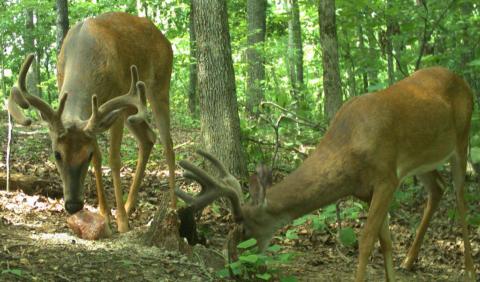Ron and Tes Jolly | Originally published in GameKeepers: Farming for Wildlife Magazine. To subscribe, click here.
If you are a frequent reader of GameKeepers Magazine, you no doubt have read about our plight dealing with feral hogs. Over the past 12 years, my wife Tes and I have been in a struggle to protect our small farm from an onslaught of these intrusive, invasive beasts. What started as a novelty sighting of a single sow and small pigs in 2004 has turned into an all-out invasion of our land. We have shot hogs at every opportunity. We have built traps and altered our farming practices, but to no avail.
Each year there are more hogs. Our turkey numbers appear to be diminishing. Body weights of mature bucks are down. Rooting damage in fields and timber is widespread and our frustration is at an all-time high.
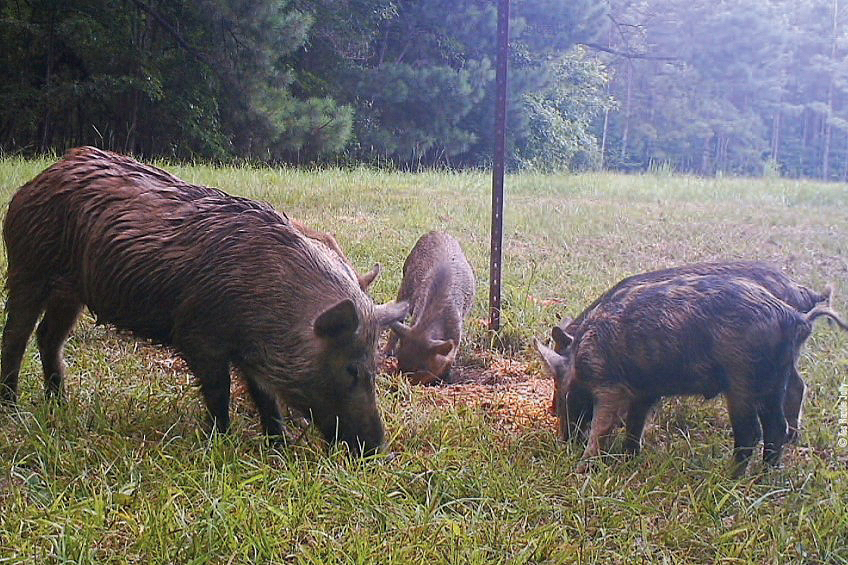
The first step toward real change is realizing what you are doing is not working. Tes and I came to that conclusion after a decade of trying to control feral hogs on our land. The next question was where do we go from here?
During the summer of 2012, Tes and I attended seminars on feral swine control at the Quality Deer Management Association’s National Conference. The expert hosting the first seminar we attended left us thinking we were on track with our efforts to control hogs. In fact, we were probably ahead of the curve. We were already doing almost everything that expert recommended.
Rod Pinkston, founder of Jager Pro, a private company specializing in feral swine control and eradication hosted the next seminar. His presentation was where we first heard the term “total sounder removal.”
By the end of the day Tes and I were confused. One expert said we were on the right track, the other said we were doing it all wrong. Five years later I can positively tell you the man who told us we were doing it wrong was absolutely RIGHT!
In 2016, after years of frustration and failure, we made the decision to change our approach to feral hog control. We were putting in the effort but accomplishing very little. In fact, we were losing.
A New Direction
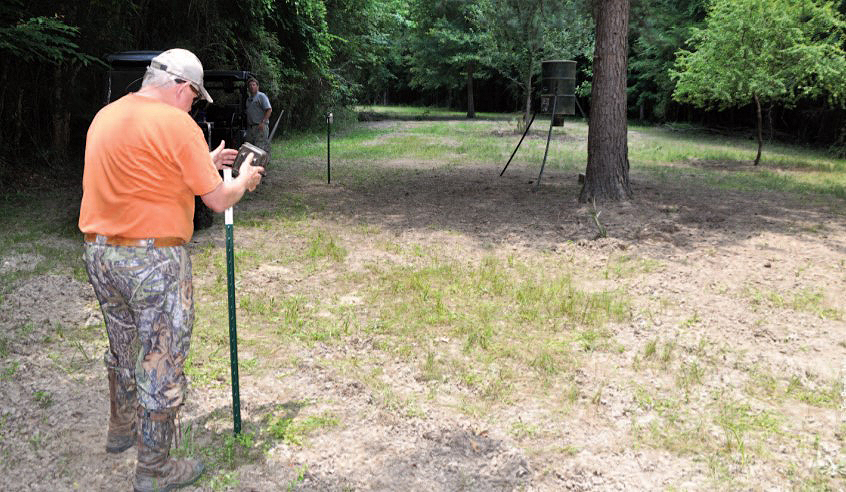
In late spring this year, our trail cameras were showing the truth of our situation. Three separate sounders were frequenting our farm on a nightly basis. There were two big sounders raiding the farm to our west and the damage was alarming. There was rooting in every food plot. Water holes were instead wallow sites for hogs. The hardwood drains on both farms were rooted and pilfered.
In early June, we ordered a Jager Pro™ Trapping System. Dr. Frazier Jones, our neighbor to the west, has the same hog problem and placed an order for two trap setups with one gate to share between them for his farm. Rod Pinkston delivered the equipment and surveyed farms, offering advice and support. At that time we did not realize just how wrong our approach to dealing with hogs had been. We were about to learn.
Pinkston did not appear to be alarmed at the damage on our farms. Instead, he calmly assured us there were better days ahead. He was certain we could turn the tide of the invasion. After he surveyed the sites we had chosen for traps, he instructed us to pre-bait the areas and notify him when hogs regularly visited the feeders.
In less than a week one sounder of a sow and six half grown pigs were hitting the baited site on our farm several times a day. The other sounders were still using the farm but had not zeroed in on the site. Hogs were consistently feeding at both sites on Dr. Jones’ farm. We called Pinkston and on June 23 he returned, ready to guide us in proper trap construction.
At the end of the day three corrals were in place. Each was built to exacting standards that Pinkston insisted be met. Each post, panel and wire had a purpose.
More Than a Trap
If you do a search for “building a hog trap” you will likely find plans that call for T-posts, cattle panels, and a door that is triggered when an animal enters the trap and trips the door. Most of these traps are small with a narrow entry that is not conducive to large numbers of animals making their way into the trap before the gate closes.
The Jager Pro system features a 35 feet diameter corral style trap designed to allow a large number of animals inside where they feel comfortable enough to stay for extended periods of time. It also touts a camera with state-of-art electronics that monitors and transmits photos directly to your computer or smart phone in a text message. The Jager Pro app allows you to make a conscious decision on when to close the trap gate. This is the foundation for “total sounder removal.”
The Jager Pro system features a 35 feet diameter corral style trap designed to allow a large number of animals inside where they feel comfortable enough to stay for extended periods of time. It also touts a camera with state-of-the-art electronics that monitors and transmits photos directly to your computer or smart phone in a text message. The Jager Pro app allows you to make a conscious decision on when to close the trap gate. This is the foundation for “total sounder removal.”
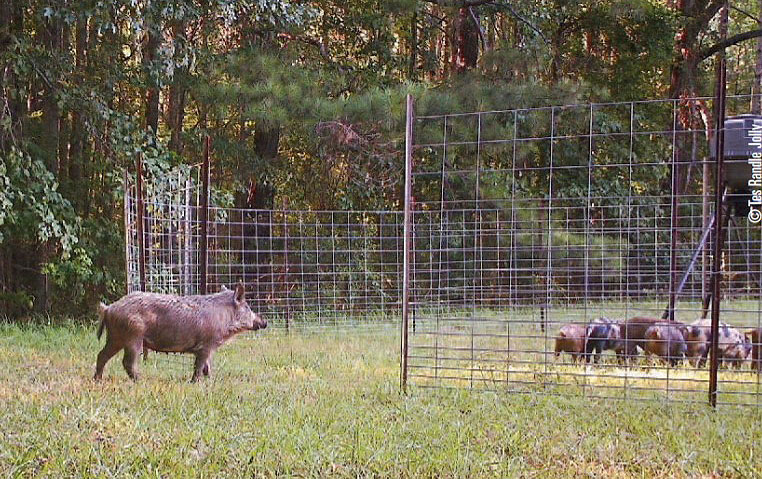
“Trapping hogs is not rocket science,” says Rod Pinkston. “If you put a trap where they want to be and put food in it, they want to eat, you will catch hogs. Problem is, each time you catch three in a group of six you educate the other three. Those hogs are not likely to enter another trap – hogs are extremely smart. Our goal is to catch the entire group.”
“We have spent years developing equipment to accomplish this goal. Our specs called for six panels 18 feet in length and five feet high. Our panels feature narrow openings at the bottom to prevent even the smallest pig from escaping. The panels are overlapped and secured with wire to connect them. The 5-foot heavy-duty panels are laid out into a circle from two T-posts set for the drop gate. The two ends are attached to the T-posts leaving a 92 inch opening for the gate. This opening should face the direction you expect the hogs to come from.”
“We use seven-foot T-posts to support the panels making sure a post is centered where two panels are joined. Posts are driven on the outside of the trap with knobs facing inward. The remaining posts are evenly spaced around the trap. Posts are driven into the ground until only four inches remain above the panels. We use 12-gauge wire to secure the panels to the posts.”
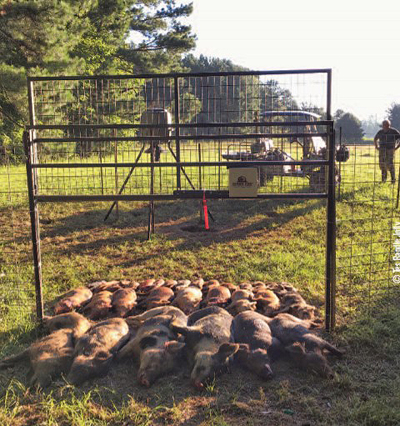
sounder may fill the gap left. Soon after the first sounder of
seven hogs was trapped, this sounder of 30 hogs moved
into the area and was caught.
“The gate opening is eight feet wide and four feet high. Hogs feel comfortable entering the trap because they are not crowded entering or once inside. When the gate drops they are not going to escape.”
Why Bother?
At the end of our day with Pinkston, three traps were in place and ready to receive a gate when the time was right. A “M.I.N.E.” (Manually Initiated Nuisance Elimination) camera was installed to monitor our trap and one of Jones’ traps. A trail camera was set to monitor the third trap site. We were urged to allow the hogs to adjust to entering the trap before installing the gate.
Barry Estes, owner of Alabama Hog Control, is an authorized Jager Pro™ dealer in our area. After our day building traps with Pinkston, I asked Estes to explain the mindset of building traps to such exacting standards.
“The last thing you want to do is educate hogs about traps,” said Estes. “The Jager Pro™ system is designed to allow a landowner to trap large numbers of hogs at one time. This is accomplished by conditioning hogs to a food source. When that is accomplished, the trap is large enough so hogs don’t feel threatened when they enter. Once they get comfortable entering the trap, a human being makes the decision to drop the gate. This prevents animals from tripping the trap and closing the gate before the entire sounder is inside.”
“Building your trap to the recommended standards is a big part of the success you hope to achieve, but there is more to the madness. Traps should be built where hogs want to be, not where you want to catch them. Try to find a place with level ground that is easily accessible. This allows you to get the equipment in and the hogs out.
“There is an old myth that says once hogs are caught in a trap it is fouled and won’t catch more hogs. That is not true. I have one trap that has caught 19 times in just over 9 months. Those 19 catches have totaled 116 hogs to date, but there are things you need to do to keep your trap effective,” says Estes.
- Location, location, location—choose a location that is likely to be used by hogs on a regular basis.
- Don’t leave hogs in the trap. Remove them as soon as possible to eliminate other groups seeing or hearing them.
- Blood inside a trap is not a deterrent to other hogs. Fecal matter is! Take the time to remove all fecal matter after a catch.
- Make sure camera and gate control box batteries are charged and ready at all times.
- Make sure the feeder has corn and is working. Set the feeder to go off once daily, preferably 30 minutes before dark to eliminate some competition for food from daylight active critters.
- Inspect the trap and gate for damage after each catch. Repair any damage.
- Be patient! Make sure the entire sounder is inside the trap before dropping the gate.
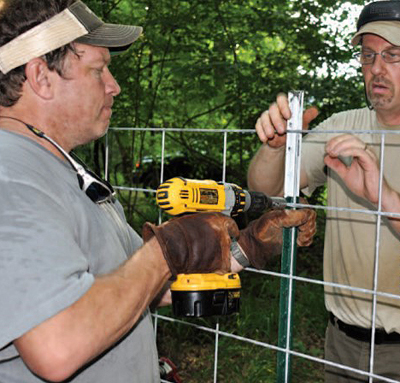
openings in the mesh on the bottom to prevent small pigs
from escaping.
“Why bother? Most landowners under siege from feral hogs feel they don’t have a choice! I think anyone who understands just how destructive these animals are would feel the same. Hogs will eat anything! It is often thought they just eat crops or mast. They eat much more, like frogs, snakes, eggs of ground nesting birds, even baby rabbits and fawns! If they find it, they will eat it. They are also very destructive to native plant communities. Left unchecked, they take over the land and out-compete native wildlife for food and space.”
Brighter Days Ahead
Since we took the leap and invested in the Jager Pro™ Hog Control System in June of this year we have caught 45 hogs in 4 drops of the gate. Dr. Jones has caught another 37 hogs on his farm. Do we still have hogs? Yes. Have we won? No.
The difference is we feel somewhat in control…before we felt helpless. The frequency of hogs on the cameras is nowhere near as often. Now, when hogs come onto our land there is a good chance the entire group will be caught and killed. That is a far cry from hoping to shoot one or two only to have the remainder of the group back the next night.
After more than a decade of fighting the feral hog invasion we finally feel we have a chance to turn things around. It will take continued commitment on our part but it will also require participation from other landowners willing to fight for their land. Education is essential. If you own land and plan to manage for the native wildlife we all love, feral hogs have no place in that plan. Hogs are attracted to the improvements we make for native wildlife and the best way to combat them is to build a better hog trap!















